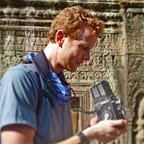Dispatch from the AIA Convention — part 1
Last Thursday, I travelled to Philadelphia for a day at the AIA Convention. In the morning keynote, Fresh Air’s Terry Gross interviewed Julia Louis-Dreyfus — an unusual choice to open a convention of architects and building design professionals. But her savvy career choices from Seinfeld to Veep belie a kind of creative process and quest for reinvention and innovation that any architect can relate to.
Celebrity aside, the most rewarding aspects of the convention are the continuing education series and networking events that bring architects from around the country together to learn from each other. For me, it was a great opportunity to meet a few of you in person and get a read on the topics most relevant to your current practice. Perhaps it’s our product-centric bias here at Arazoo, but it seemed to me that seminars about products — especially in the context of ingredient declarations — were quite popular.
But one critical topic was conspicuously under-represented: technological innovations that make institutional knowledge more accessible and valuable. That’s a missed opportunity, as far as we’re concerned! As many of you know, my Arazoo co-founder, Barry LePatner (an Honorary AIA member himself) speaks frequently about how advanced technology is in the early stages of transforming the AEC industry, and how firms need to become early adopters to maintain a competitive advantage against commoditization.
While there were interesting examples of innovative technology aiding the design process, there didn’t appear to be much on offer that leveraged technology to improve workflow productivity or product knowledge retention.
Case in point, I attended a terrific seminar that spoke about the importance of thinking about products not only as individual components, but also as complex assemblies, especially in the building envelope. There’s a mountain of research that goes into analyzing and selecting high performance assemblies entailing tons of data, from energy calcs, to LCAs, to material ingredient transparency and disclosure. But there was no discussion on smart ways to organize and share this data once you have spent enormous amounts of time collecting it all!
Product and material research and selection is only becoming more complex. If you don’t have a smart information management system in place to capture, retain and quickly retrieve that learning, you’ll find yourself at a disadvantage to those firms that do.
This lack of product information management tech came up again at a presentation of two Living Building Challenge case studies. Sustainability Directors from two of the largest firms in the country talked about how that their teams conducted so much product research that they couldn’t send their non-profit clients a bill for it. That’s laudable, but not sustainable for a large firm, let alone a small or midsize one.
The surprising thing is where all that hard won and expensive research ended up. It was saved as PDFs in nested file folders on their firms’ servers. We know that process yields little benefits to the firm in the way of easy retrieval and seamless collaboration. What kind of ROI is there when the next team can’t easily find the information that took hundreds of hours to discover in the first place?
In next week’s post, I’ll dive a little deeper into the product ingredient declarations that many were discussing, and how your team can make it easier to collect, share, and augment that research and knowledge from project to project.
Brad Cronk is an AIA member, LEED BD+C Professional, and co-founder of Arazoo.
Be sure to check out our new video to see how simple it is to create a digital product library in Arazoo that makes your product knowledge a valuable firm asset.
